Jawbone UP3 Review
Jawbone UP3
Updated: Jawbone's second UP3 is more secure, but is that enough?
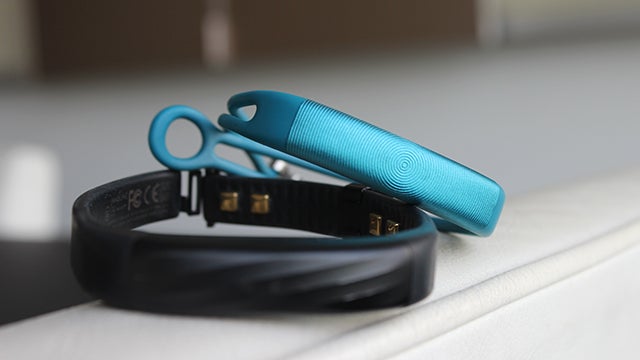
Verdict
Pros
- Sleek, attractive design
- Useful smart coach
- Strong third party app support
Cons
- Clasp regularly becomes loose but addressed with new version
- Difficult to switch between tracking modes
- Some ocassional syncing issues
Key Specifications
- Review Price: £129.99
- Medical-grade rubber design
- up to 7 days battery life
- 38mAh battery
- Blueooth 4.0 LE
- Tri-axis accelerometer
- Heart rate sensor
- Works with select Android and iPhone
Since our original review, Jawbone has released a new UP3 model, which offers a tighter clasp. We’ve updated our review and score based on the changes made with the new UP3 model.
As I’ve mentioned in my updated UP2 review, Jawbone introduced a second generation UP3, just months after launching the first one. Confused? Don’t worry, I don’t blame you.
The new UP3 comes in an array of new colours and, crucially, now comes with an improved clasp. This addresses my biggest issue with the first generation version. It had a habit of coming loose.
Unlike the UP2, the UP3’s updated clasp design doesn’t look radically different to the original. In fact, the two appear identical as you can see in the image below. It’s all down to the clasp, which appears to fasten all that more tightly in place than the previous version.
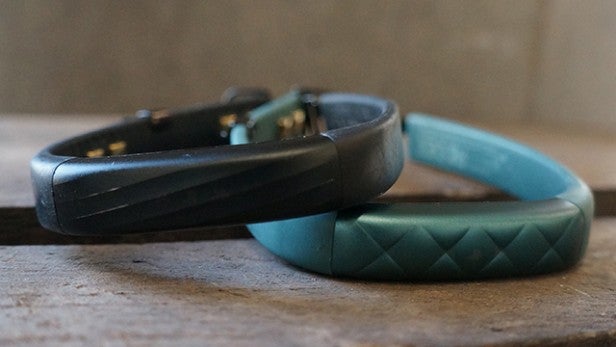
Jawbone has stated that the heart rate tracking sensors has meant that they were unable to adopt the same redesigned strap featured in the second generation UP2. Still, the new clasp on the UP3 feels considerably more secure.
I’ve been wearing the new UP3 alongside the replacement for the troublesome UP2 and I can confidently say that I haven’t experienced any of the issues that I had with its predecessor.
It’s not got trapped in my clothes or fallen off when I got to sleep either. From a tracking perspective, nothing has changed. The new software update offers some slight improvements with the type of heart rate data you can generate, but it’s more of the same. Smart coach is as useful as ever and, it’s still offers one of the most convincing fitness tracking ecosystems.
Would I recommend it? I’d still be inclined to go for the UP2, as I’m not sure Jawbone makes the best use of the heart rate monitor. Plus the UP2’s strap feels like it has done a better job of addressing the issue.
If you’ve bought a troublesome UP3 and the usual clasp troubleshooting does not solve your issues, owners with a valid warranty should be able to get a replacement with the tighter clasp. I just wish Jawbone got this right in the first place, though.
What is the Jawbone UP3?
The Jawbone UP3 is an activity tracker with a turbulent past. It was scheduled to launch in 2014 until the company decided to delay its release until 2015 for undisclosed reasons. Now it’s here and claiming to be Jawbone’s most advanced tracker yet. On paper there’s plenty to backup this claim, with the device featuring a radically new look and the addition of heart rate monitor to track even more aspects of your day.
At £130, the UP3 is £40 more expensive than the Jawbone UP2, which comes without the heart rate support but is virtually identical in every other way. We weren’t exactly enamoured with the changes that Jawbone made with the UP2 in comparison to the great UP24, and disappointingly it’s more of the same with the UP3.
Related: These are the 10 best activity trackers you can buy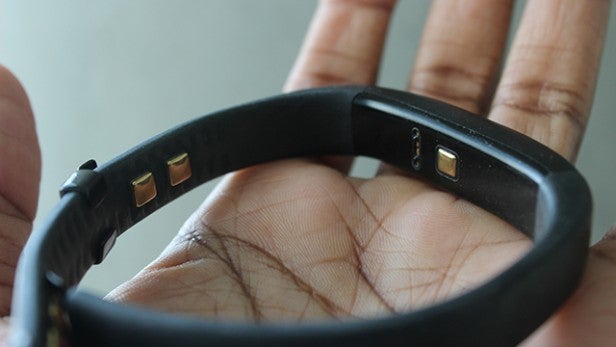
Jawbone UP3 – Design and features
From a distance the UP3 is everything you could want from a tracker. It’s slim, weighs just 29g and looks far more elegant than Fitbit’s trackers. Nowadays, only the Misfit Ray can give it competition for subtlety. If you like your monitoring to be discreet, then the UP3 fits the bill. Especially if you opt for the black model. It’s a radical overhaul of the design we saw with the UP24, where the more rigid rubber frame is replaced with a skinnier, more flexible medical-grade rubber band that wraps around the wrist in a natural, more accommodating way.
Like the UP2, there’s an aluminium metal casing on the top of the UP3. It’s a slightly different finish to the UP2 but doesn’t detract from what is a great-looking tracker you’d actually want to wear. But, with ongoing use I noticed a few issues.
During my time using it, the metal began to scratch away in places. This is where the notification lights lie to indicate daily activity tracking, sleep monitoring and smartphone notifications. Before a recent firmware update, you had to swap between activity and sleep tracking by tapping on the small display, which never worked reliably. Thankfully, sleep tracking is now automated so there’s never a need to interact directly with the band. It means the capacitive touch area is now completely redundant.
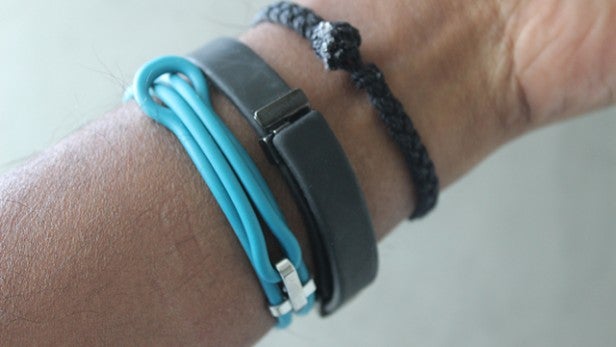
If you care about having a water resistant tracker to go swimming with, then the UP3 will disappoint as it’s only splash proof. The splash proofing means you can go running in the rain with it or wash the dishes and take it in the shower. We tested in all three scenarios and can safely say that the UP3 survives.
To keep things secure the wearable features an aluminium metal clasp that can be moved up and down the band to offer a one-size-fits-all design. Jawbone says it should fit wrist sizes ranging from 140mm to 190mm but you’ll need to make sure it’s a tight fit if you want its heart rate tracking services to deliver accurate data.
This is where the problems begin to surface with the original UP3. On numerous occasions the clasp came loose. Thankfully the only time it actually fell off my wrist was when I was in bed, as opposed to out in public. Thankfully, the new revised model isn’t plagued with such issues. While the clasp is still more fiddly than most to get on, it does at least stay secured.
If you look inside of the strap you’ll find identically positioned charging pins as there is on the UP2, so you can use the same magnetic USB charging cable to power up the built-in 38mAh battery packed into the tracker. That also means it’s the same very short cable that makes it tricky to keep the band securely in place to charge, especially when it’s plugged into a computer.
You’ll also spot five gold coloured square pieces of metal. These are responsible for delivering the resting heart rate data. This is an entirely different set up to the optical heart rate sensors I’ve seen on the Fitbit Charge HR and the Mio Fuse, for instance. Instead of flashing lights against the skin, Jawbone uses biompedance technology that measures the resistance of body tissue to tiny electric current.
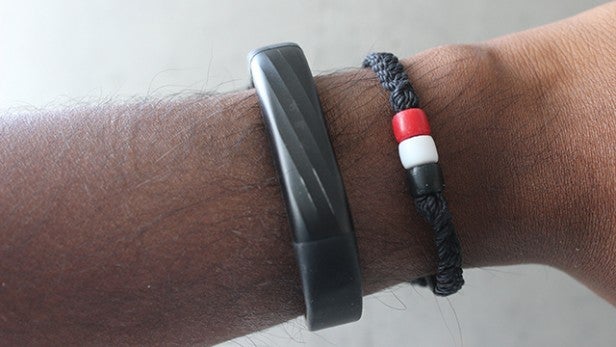
It sounds like it has more in common with the EKG monitoring you get with a heart rate monitor chest strap like the Polar H7. This method not only captures heart rate data but can also monitor respiration rate and galvanic skin response, which sounds a lot like the Microsoft Band.
Before Jawbone’s recent firmware update, the sensor was only capable of monitoring resting heart rate, but continuous support has now been added. The data lets you determine when you’re most active and measure cardiovasular health levels.
It means the UP3 can take passive heart rate measurements every 10 minutes provided your stationary. It will delay the reading if you remain moving when it starts a test. This heart rate data throughout the day is a great way to track your overall well-being and make better informed comparisons between different days.
Crucially, despite being so close to the skin, the heart rate sensor doesn’t make the band uncomfortable to wear and Jawbone should be applauded for getting that right at least. This approach also has another benefit over optical sensors and that’s improved battery life in comparison to optical sensors.
Jawbone UP3 – App
The Jawbone app and its ecosystem on the whole continues to shine, even if questionable decisions are being made in the hardware department. With no screen on the UP hardware, you’re still relying on your smartphone to review all of the data. It’s still compatible with the same platfoms and like the UP2, requires a separate app from the one used with the UP24.
The UI hasn’t changed all that much from last year. You still have the two activity and sleep progress bars at the top with a feed below of your activity. So in our case, there’s a lot of runs logged through Runkeeper. That’s one of the many third party apps you can use with the platform and makes it easier for those who use existing apps to integrate data into Jawbone’s platform. 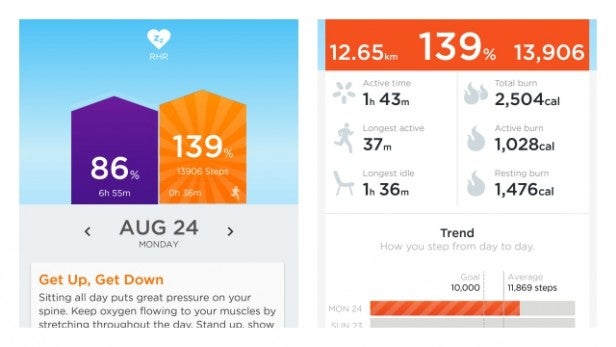
Like Misfit, this is also extended to device support. So with Nest it can help create the ideal sleep environment or combine with Samsung’s SmartThings platform to control lights or small appliances. There’s also a host of training and insights that can be integrated into the platform as well.
Over on the left is a drop down menu where you can view and adjust goals, see sleep and activity trends, have a look at how fellow Jawbone friends are getting on and get competitive with the Duals mode. On the right is the hardware settings where you can view battery life, manually activate sleep logging, set up smart alarms and find useful idle alerts. These can be set up to go off every fifteen minutes for up to two hours and will send a small vibration to the band to remind you to get up and move.
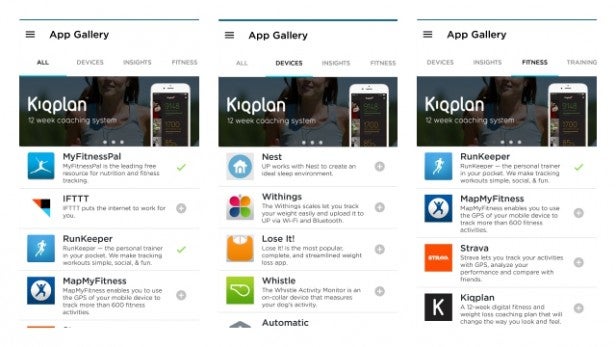
There’s a couple of new notable features that helps on the logging and motivation side of things. The first is the little plus sign, which now pulls up an overlay with shortcuts to Workout, Mood, Food, Weight, Sleep. It’s a very simple addition, but makes it easier approach to logging data. If you go for a run, the band will automatically track the activity but you’ll need to manually assign a label to it.
Then there’s Smart Coach, Jawbone’s standout feature. Unlike most other trackers, data is analysed to give more contextual advice on how to make improvements. Sometimes it’s simply handy trivia to make you more aware of health measures to take, like the fact that 6 minutes of reading can heavily reduce stress. If you’re a runner it’ll also deliver quotes of motivation to lace up your trainers. The Smart Coach can tell you when is the best time to go to bed as well as the positive side effects of earlier kip. It really is a great addition to the data analysis and making more sense of that information.
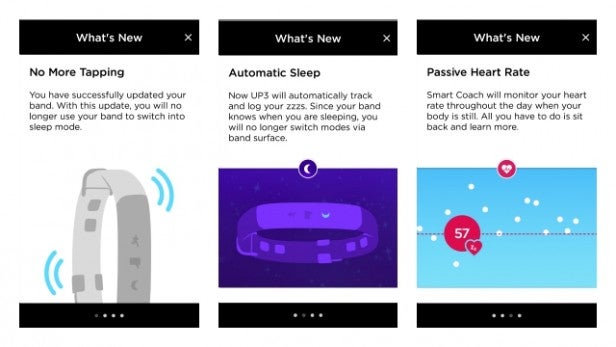
Jawbone’s latest firmware update adds automatic sleep tracking and continuous heart rate monitoring
Jawbone gets a lot of things right with its smartphone app. It’s a consistent experience across multiple platforms. It’s easy to use, and while the level of graphical analysis are not that different from what Fitbit and other competitors offer, the Smart Coach is a real asset that will hopefully only get better.
Jawbone UP3 – Performance and Battery Life
Putting my concerns with the strap secureness to one side, I was hoping for the Jawbone UP3 to restore or faith in the tracker after my underwhelming experience with the UP2. But, after a few weeks of using it, I didn’t experience any notable improvements – though there are plenty of signs suggesting the UP3 could offer more than its closest rivals can on a longer term basis.
Motion tracking accuracy is something I’ve highlighted in pretty much every tracker I’ve reviewed. There’s not one wrist-worn fitness wearable that has really nailed it. That’s because there’s always going to be a disparity when each vendor uses different algorithms and, ultimately, wrist trackers are nowhere near as accurate as their ankle or shoe competition.
For step count, I compared it to the Fitbit Charge HR, which also uses a three axis accelerometer to record movement. There was a 700-800 step difference on average. I was hoping those scores would generally be much closer but that’s quite a big difference.
![]()
Left to right: Fitbit Charge HR vs Jawbone UP3 distance tracking
Along with simple step counting, the UP3 will try to recognise when you’re doing certain activities. So if you go for a run, it’ll identify that when the data is logged. It works, generally, but putting it up against the TomTom Runner sports watch, I found it takes five or so minutes to acknowledge that you”re not just strolling down to the shops.
Heart rate monitoring is the most interesting aspect of the UP3 but it’s not new. Until very recently, you could only record resting heart rate data and that required making sure you monitored your sleep to get a reading. While that resting heart rate information is valuable, continuous heart rate monitoring is far more insightful.
Inside the app you’ll see the heart rate icon, which pushes you through to a heart health section. Here you can see resting heart rate and passive heart rate data that’s plotted on a graph that’s not all that easy to decipher. What I did discover is that my resting heart rate average 49 was below the American Heart Association’s recommended 60-100bpm. Apparently that 49 score is actually closer to what well-trained athletes should aim for, so it wasn’t all bad news. I also made resting heart rate comparisons with the Fitbit Charge HR and there was a difference of one or two BPM, so it’s at least as accurate as its nearest competitor.
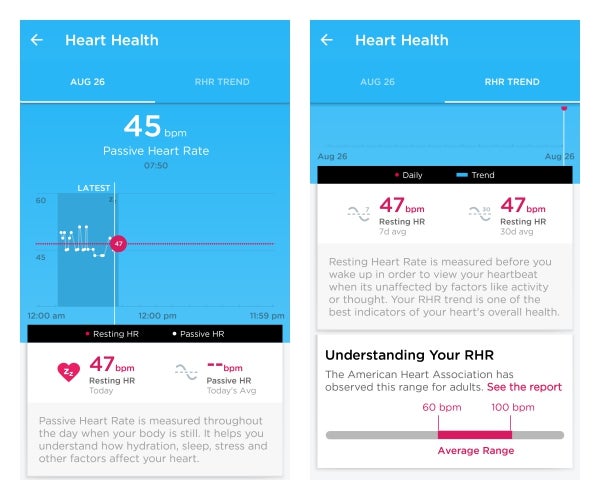
To test the continuous heart rate tracking, I put it up against the TomTom Runner paired with the Polar H7 heart rate sensor. Unfortunately, the data wasn’t so insightful. While the Runner and the chest strap heart rate monitor told me I averaged 158bpm and broke down time spent in heart rate zones, the UP3 had no record of the data.
Sleep monitoring is one of Jawbone’s strengths, at least when you can get it activated. Thankfully that new firmware update means it can now be done automatically .
I tested the automatic sleep tracking against the Fitbit Charge HR, which offers the same feature. The numbers kind of speak for themselves. The Fitbit was generally more erratic in its recordings. The results from the UP3 are more detailed and more reliable. The Smart Coach will pick up when you’re not getting enough sleep and suggest earlier bed times or reveal the effects of a bad night’s sleep.
![]()
Left to right: Fitbit Charge HR vs Jawbone UP3 sleep tracking
If you’ve use the UP3 24/7 then you can expect to get a week’s worth of battery life and not much more. That’s down from the two weeks the UP24 manages, although that didn’t have to accommodate a heart rate sensor sapping the power out of it. While I have my grievances with the charging cable, the UP3 is a quick charger letting you get back to tracking in around an hour.
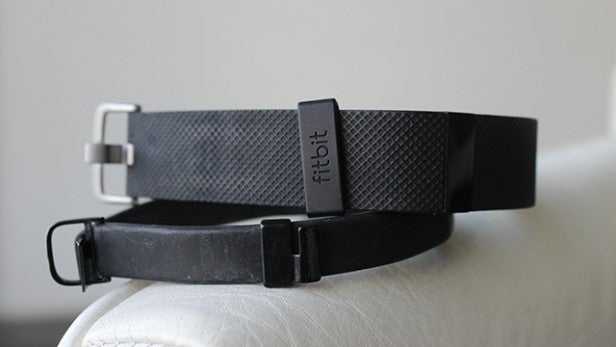
Should I buy the Jawbone UP3?
I’d like to talk about how nice the Jawbone UP3 looks and how much we love the smart coach features and extensive third party app integration. Jawbone has, to an extent, addressed the main complaint around the insecure clasp on the first generation of the UP3, although it still remains tricky to put on.
However, if you have £130 and want an activity tracker that offers similar features, then the Charge HR is a better option. It’s £10 cheaper than the UP3 and we found offers accurate heart rate tracking and a more secure strap. You will have to make compromises though. It’s not as sleek as the UP3 on design the software lacks the analysis that Jawbone’s platform can offer. If you can live with a not so pretty design and the smart coaching features, then it’s a good option.
Otherwise, the UP2 is a better choice, too. While it sacrifices the heart rate monitoring, it isn’t a major loss as Jawbone hasn’t used the data in the most useful and meaningful way.
Verdict
Even with the extra features added by the latest firmware update, the Jawbone UP3 still doesn’t quite match rivals


